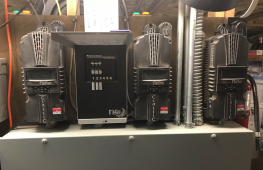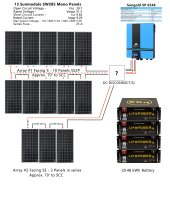Quick question here: I'm getting my solar ready to install and was wondering about dc disconnects. I will have two different arrays installed on the roof. 1 string of 8 in series of 305W panels (Voc of 40V) and another string of 6 in series 305W panels (also each at Voc of 40V). I have a Sol-Ark 5k inverter with 2 solar panel inputs (MPPT1 and MPPT2). Solar Panel String 1 will feed MPPT1. String 2 will feed MPPT 2.
The closest direct path to my inverter in the garage will be through the roof. I will be using a Soladeck enclosure to feed the dc wire through the roof into a flexible metal conduit that will terminate into a metal wireway to feed into the Sol-Ark.
From what I have gathered, since I'm not paralleling any panels, no combiner box is needed, nor fusing. The Sol-Ark has a pv dc disconnect integrated into the unit. Do I need a pv dc disconnect between the inverter and the panels? If so, is there harm in putting a dc disconnect inside in the garage? I have seen some examples mainly in Australia where they require DC isolators where these types of disconnects have failed or caught fire due to shorts due to water penetration of the enclosure.
My locality does not require rapid shutdown, and I'm not planning on installing any automatic rapid shutdown device.
I already have an IMO dc disconnect, so I'm not sure if there would be benefit to installing it or not. With the amount of voltage in my system, I'm a little leery of any additional contact point that could pose a potential failure point. Thoughts?
The closest direct path to my inverter in the garage will be through the roof. I will be using a Soladeck enclosure to feed the dc wire through the roof into a flexible metal conduit that will terminate into a metal wireway to feed into the Sol-Ark.
From what I have gathered, since I'm not paralleling any panels, no combiner box is needed, nor fusing. The Sol-Ark has a pv dc disconnect integrated into the unit. Do I need a pv dc disconnect between the inverter and the panels? If so, is there harm in putting a dc disconnect inside in the garage? I have seen some examples mainly in Australia where they require DC isolators where these types of disconnects have failed or caught fire due to shorts due to water penetration of the enclosure.
My locality does not require rapid shutdown, and I'm not planning on installing any automatic rapid shutdown device.
I already have an IMO dc disconnect, so I'm not sure if there would be benefit to installing it or not. With the amount of voltage in my system, I'm a little leery of any additional contact point that could pose a potential failure point. Thoughts?




